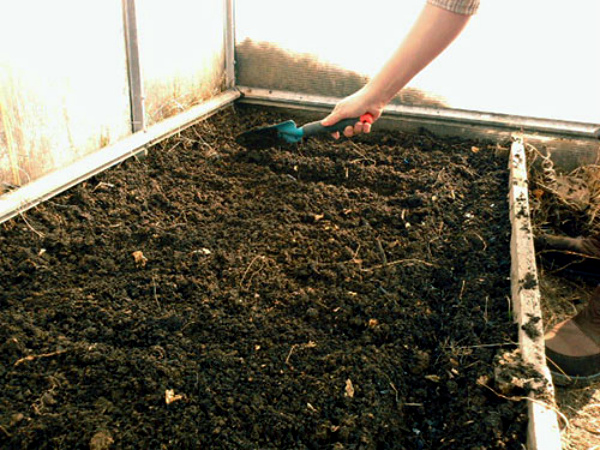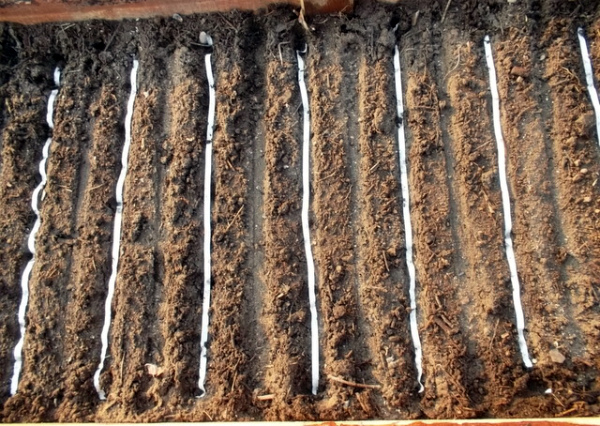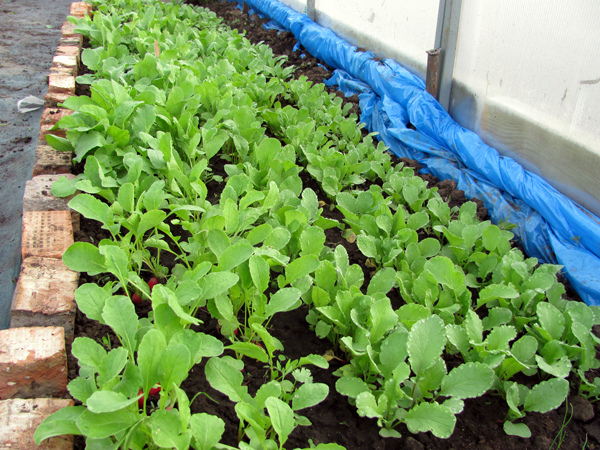Secrets of planting radishes in a greenhouse
Content
Variety selection
In principle, any type of radish can be grown in a greenhouse, but since the main goal of every vegetable grower is to obtain a fast and high-quality harvest, early ripening and early varieties should be planted. Early maturing means that the radish has a short ripening period, while early means that it can be planted in early spring and tolerates low temperatures well.
There are many varieties of radish that combine these qualities:
- "18 days" - the period of maturation of the radish really corresponds to the name (18–20 days), the roots of this variety are oblong, red in length, and white at the tip, the pulp is juicy, soft, mild in taste;
- "Firstborn F1" - smooth, large (30–35 g), round-shaped red roots ripen in 16–18 days, a high-yielding variety (3–3.5 kg per 1 m2 of area), resistant to cracking, juicy pulp, without bitterness ;
- "Children's F1" - according to the manufacturer's instructions, radishes of this variety can be harvested after 16 days from the emergence of shoots, the roots are small (15–20 g), red, the pulp is juicy, slightly spicy;
- "Ultra early red" - the ripening period is 20 days, the roots are red, medium-sized (up to 15 g), the pulp is juicy, almost not spicy, the leaves of this radish are tender and not prickly - they can be used in the preparation of salads, soups;
- "Heat" - early ripe (20-21 days) radish with bright red roots, designed specifically for growing in a greenhouse, high-yielding, weakly spicy pulp, does not tolerate high temperatures, so the greenhouse needs to be ventilated more often, especially if the construction is made of polycarbonate;
- "Presto" - very early radish, ready for harvesting on the 16th day from the emergence of shoots, the roots are red, beautiful and even, the flesh is white, juicy, the variety is intended for early planting in the greenhouse;
- "French breakfast" - elongated, raspberry, with white tips, roots ripen in 20-25 days, the pulp is juicy, soft, mild taste;
- Celeste F1 is a high-yielding early Dutch-bred radish that ripens in 20-21 days, the roots are smooth, round, red, have a mild taste and excellent presentation.
Sowing preparation
Planting early radishes in a polycarbonate greenhouse requires preliminary soil and seed preparation.
The soil should be prepared a couple of months before the seeds are sown. For radishes, which are planned to be planted in early spring, the soil is prepared in the fall. All plant residues are removed from the future bed, humus or compost is added and dug up.
Radish prefers well-drained soil with neutral acidity. If the land in your greenhouse does not meet these characteristics, then it needs to be adjusted. To improve the drainage properties, you can add peat, wood ash, a little river sand, to reduce acidity - add slaked lime or dolomite chips. If vegetables are regularly planted in the greenhouse, the soil does not rest and is quickly depleted.Before planting radishes in such soil, it is necessary to add mineral complex fertilizers containing phosphorus and potassium.
Plant radish seeds in warm soil. Shortly before sowing is carried out, the ground is covered with foil. If radishes are planted in a greenhouse in winter, then the best way to warm up the soil is to pour hot water over it, and then cover it with foil for 2-3 days. In the spring period (March-April) there is no need to warm up the soil, since favorable conditions in the greenhouse are created naturally.
When purchasing radish seeds, select special varieties for greenhouse cultivation. Although store seeds are usually already processed, there is no need to prepare for them. The material needs to be calibrated - select the largest seeds (3 mm and more), then soak for a short time in warm water. If some of the seeds did not sink to the bottom, but floated up, this is a sign that they are empty - such seeds are not sown. Those seeds that have sunk to the bottom are placed in a weak solution of potassium permanganate for 20-30 minutes for disinfection, after which we put them in a damp cloth for a couple of days to germinate.
Sowing technology
Sowing radishes in the greenhouse is done manually. On a previously prepared bed, shallow (2-3 cm) continuous furrows should be made at a distance of 7-10 cm. Radish loves moisture, so the bottom of each hole should be well watered, and after the moisture is absorbed, sow the seeds. Technically, there are two ways to plant radish seeds:
- Place the seeds at a distance of 3-4 cm in a checkerboard pattern along the entire length of the row. The method, of course, is troublesome, but its advantage is that such a planting will save you from further thinning the radish shoots.
- Sowing seeds can be done densely, but in this case, the radish will need to be thinned out as soon as the plants have a couple of real leaves. All weak shoots should be removed, leaving the strongest at a distance of 4-5 cm.
Whichever way of sowing is carried out, it must be remembered that radish has a superficial root system, so you need to plant the seeds shallowly - a depth of 1–1.5 cm in the greenhouse will be enough. After sowing the seeds, the garden bed should be well watered. In the first days after sowing, it is better to maintain the temperature in the greenhouse at + 15 ° C, then the seeds will germinate faster.
If radishes are planted in a polycarbonate greenhouse, then there is a need for more careful control over humidity and temperature, since polycarbonate structures heat up faster. This is very good for radishes grown in autumn and winter, but too high a temperature for spring radishes is dangerous - the seedlings will stretch out, and the roots will not form.
Growing features
For the most successful growing of radishes in a greenhouse, two basic conditions must be observed: soil moisture and temperature. During the entire growing season of radish, the temperature is adjusted several times. Within 2-3 days after the seeds are planted in the ground, the temperature is maintained at + 15-18 ° C. After emergence, the degree is lowered to + 8-10 ° C so that young shoots do not stretch out. When the tops grow back, the temperature is raised again to + 15–20 ° C - such conditions are necessary for the formation of root crops.
Since radishes need moist soil to grow, special attention is paid to irrigation. Until shoots appear, you need to water the radishes daily, and then you can switch to the regime 1 time in 2-3 days. It is necessary to ensure that the soil does not dry out, since the lack of moisture makes the roots coarse, and if the garden is watered abundantly after a drought, they will crack. After watering, the greenhouse should be ventilated - a high level of air humidity contributes to the development of fungal diseases. You also need to ventilate the greenhouse at temperatures above + 20-22 ° C.
Daylight hours for radishes should be about 12 hours. If the crop has to be planted in winter, then you need to think about additional lighting. Also, when growing winter radishes, you should take care of heating the greenhouse. Feed the plants only if the soil is depleted by the continuous cultivation of early vegetables. Since greenhouse radishes are planted in the same soil as in the garden, it is not surprising that sometimes it gets sick. For the prevention of fungal diseases, plants need to be sprayed from time to time with a solution of ash and soap in the proportion of 1 glass of ash, 50 g of soap / 10 l of water.
Video "The trick when planting radishes in a greenhouse"
This video will show you what little trick you can use to plant radishes in your greenhouse quickly and easily.






